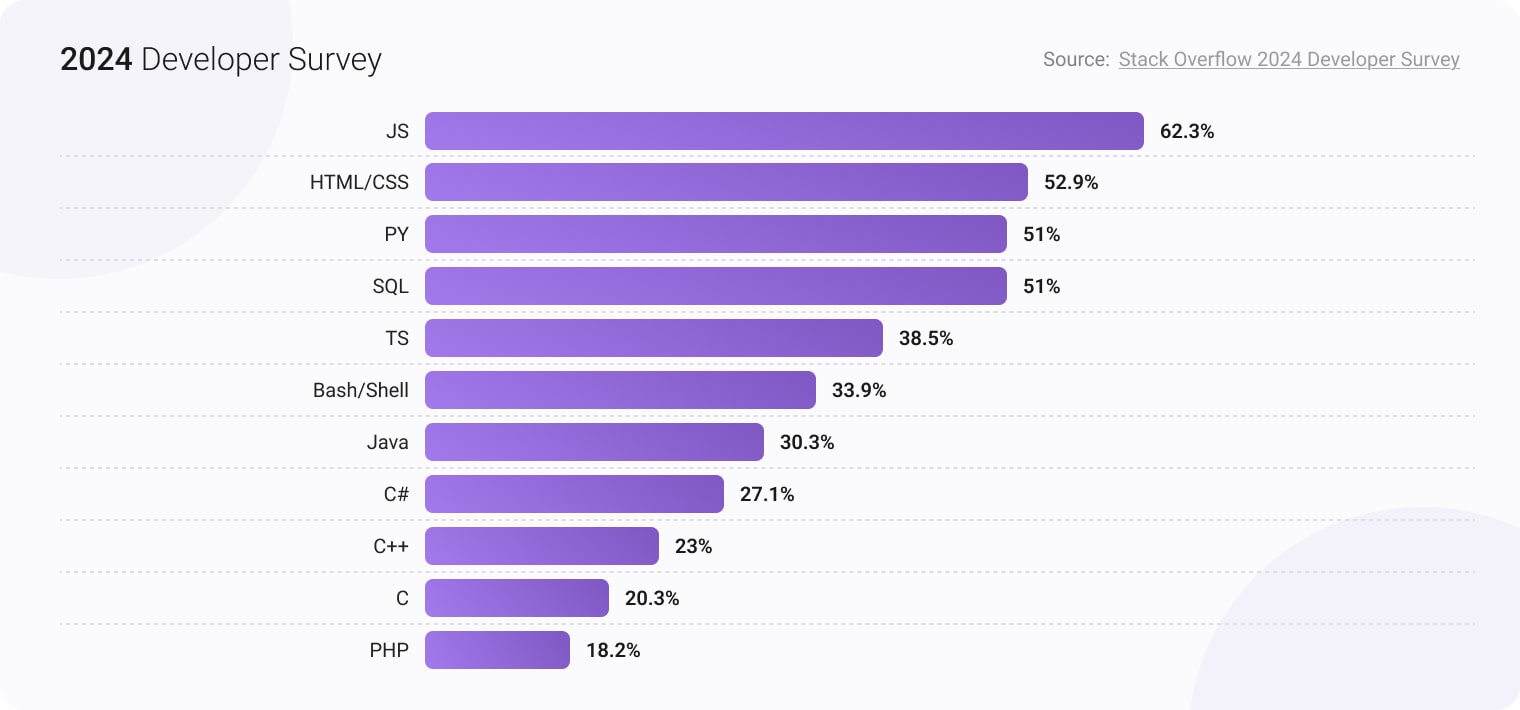🧠 Why JavaScript Still Matters in 2025
 K Manoj
K Manoj
🔸 Introduction
In the current scenario of technology that’s constantly evolving—where AI, WebAssembly, Rust and new frameworks are gaining traction—one language has stood the test of time. Javascript. As we are progressing forward, many developers wonder: Is Javascript still relevant? The answer is a resounding yes—and not just relevant, but critical to modern development.
Whether you’re a beginner learning how to print Hello World in your first programming language or a senior architect designing cloud-native apps, Javascript remains a pillar of the software ecosystem. Here's why it still matters—and why it’s not going anywhere.
1️⃣ The Number Game
Let’s first discuss the numbers, might be boring but still relevant.
Javascript is the most popular programming language with approximately 97% websites using it.
According to the TIOBE Programming index, JavaScript has reached its highest position since 2001.
Javascript accounts for 95.86% of the market share compared to Java simply because it has more users showcasing its overwhelming dominance in web development.
2️⃣ Full-Stack Development Supremacy
Javascript’s evolution from browser-only language to a full stack powerhouse remains to be it’s greatest strength. It runs natively in all modern browsers—making it the default language of the web. Although, advances do exist in WebAssembly and other alternatives, you can't build truly interactive websites without JavaScript. From button clicks to async data fetching, it's the glue holding the frontend together.
Thanks to Node.js and frameworks like Express, NestJS, and Next.js, developers can use JavaScript to write frontend, backend, and even database logic. This reduces context switching and allows teams to build entire apps with one language.
3️⃣ Framework Ecosystem is More Powerful Than Ever
In 2025, JavaScript's ecosystem is not just thriving—it’s leading the innovation curve. React, Vue, Angular, Svelte, Solid, and Qwik offer varied paradigms for building ultra-fast, scalable apps. From server-side rendering to streaming and partial hydration, JavaScript frameworks continue to evolve.
Well, now talking about AI which is buzzing everywhere, Javascript developers are stepping into this sphere of tech as well. With Node.js leading the way, the emergence of frameworks like Transformers.js allows developers to run sophisticated AI models directly in web browsers and Node.js applications enabling client-side AI processing and reducing server costs. TensorFlow.js is one another framework specializing in custom ML solutions and production optimization.
4️⃣ Enterprise Adoption and TypeScript Growth
TypeScript is already among the top 5 programming languages with a popularity of 38.5%. With the rise of TypeScript, Large enterprises increasingly adopt TypeScript for its type safety, better tooling, and maintainability. This trend bridges the gap between JavaScript's flexibility and enterprise-grade development requirements.

5️⃣ Serverless, Edge, and Real-Time Capabilities
JavaScript excels in event-driven, asynchronous environments, making it perfect for serverless and edge computing reason being it’s lightweight nature and fast startup times. Platforms like Vercel, Cloudflare Workers, and AWS Lambda run JavaScript code at lightning-fast speeds across the globe.
6️⃣ Unmatched Community and Package Ecosystem
With millions of npm packages, thousands of tutorials, and vibrant developer communities, JavaScript remains the most supported language in the world. Whether you're debugging in Stack Overflow or learning through YouTube, help is always a click away.
7️⃣ WebAssembly Compliments, Not Replaces
To understand this better, let’s first look at how WebAssembly work.
WebAssembly is a low-level assembly-like language with a compact binary format that runs with near-native performance in web browsers. Let’s look at the below flowchart to understand it’s intricacies;

So basically this is how a typical WebAssembly code would work in close quarters to Javascript
Thus we can say that, WebAssembly is powerful for performance-critical applications, but JavaScript is still required to interact with the DOM, handle UI logic, and orchestrate user interactions. The two coexist, with JS acting as the controller.
8️⃣ Cross-Platform: From Web to Mobile to Desktop
Highlights the one-codebase-multiple-platform strategy. JavaScript can now power mobile apps (React Native, Expo), desktop apps (Electron, Tauri), and even embedded systems. Its cross-platform capabilities make it a go-to for startups and enterprises.
9️⃣ Easy to Learn, Hard to Master
It’s still the best language to learn first. With just a browser and a text editor, anyone can start coding in JavaScript. But beyond that simplicity lies a deep, complex ecosystem that can power enterprise-grade applications.
⛳️ Conclusion : JavaScript Isn’t Just Alive—It’s Evolving
JavaScript in 2025 is not a relic—it's a dynamic, constantly evolving, cross-platform powerhouse. It adapts to trends, integrates with cutting-edge technologies, and still powers the core of web development. Whether you're building a real-time dashboard, deploying a serverless backend, or training ML models in-browser, JavaScript is still your best friend.
Subscribe to my newsletter
Read articles from K Manoj directly inside your inbox. Subscribe to the newsletter, and don't miss out.
Written by

K Manoj
K Manoj
Backend Web Developer | Security Enthusiast |